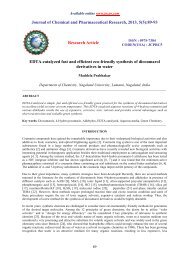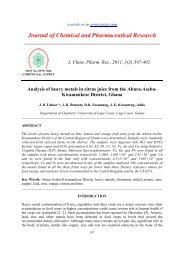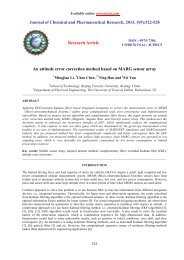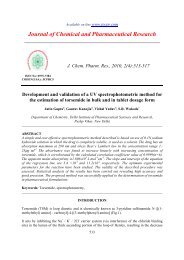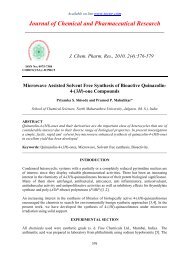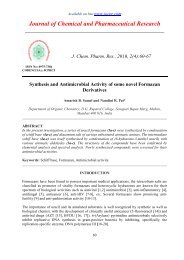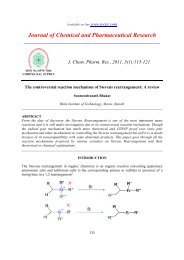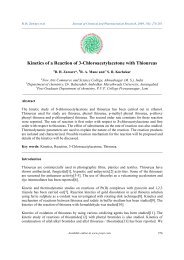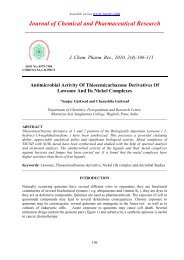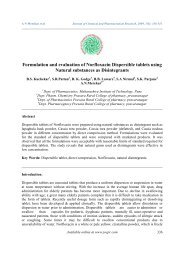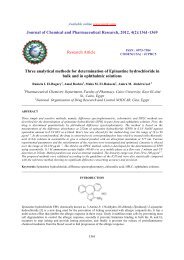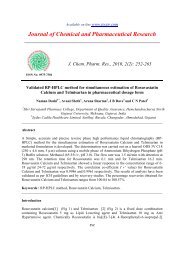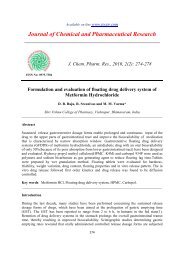Effect of Zinc and Sulphur on herb, oil yield and quality - Journal of ...
Effect of Zinc and Sulphur on herb, oil yield and quality - Journal of ...
Effect of Zinc and Sulphur on herb, oil yield and quality - Journal of ...
Create successful ePaper yourself
Turn your PDF publications into a flip-book with our unique Google optimized e-Paper software.
Ajay Kumar et al J. Chem. Pharm. Res., 2010, 2(4):642-648_____________________________________________________________________________kg K 2 O/ha (5); 150 kg N, 35.2 kg P <str<strong>on</strong>g>and</str<strong>on</strong>g> 50.4 kg K/ha (3), <str<strong>on</strong>g>and</str<strong>on</strong>g> 200 kg N, 24 kg P <str<strong>on</strong>g>and</str<strong>on</strong>g> 50 kg K/ha(12) in different menthol mint genotypes has been reported from different parts <str<strong>on</strong>g>of</str<strong>on</strong>g> the country.The total <strong>herb</strong>age <strong>yield</strong> in both the years was found to be highest due to applicati<strong>on</strong> <str<strong>on</strong>g>of</str<strong>on</strong>g> 130% <str<strong>on</strong>g>of</str<strong>on</strong>g>NPK +Zn + S followed by 130% <str<strong>on</strong>g>of</str<strong>on</strong>g> NPK + S treatment. This may be because <str<strong>on</strong>g>of</str<strong>on</strong>g> combined affect<str<strong>on</strong>g>of</str<strong>on</strong>g> nutrients as sulfur has synergism with nitrogen availability. Thus better utilizati<strong>on</strong> <str<strong>on</strong>g>of</str<strong>on</strong>g> nitrogenunder sulfur treatments may have led to more <strong>yield</strong>. Similarly the sulfur treatment <str<strong>on</strong>g>of</str<strong>on</strong>g> 9 ppm inMentha arvesnsis L. var. MAS –1 (13), <str<strong>on</strong>g>and</str<strong>on</strong>g> 20 kg/ha in Cori<str<strong>on</strong>g>and</str<strong>on</strong>g>rum sativum L.(11) has beenreported to increase growth parameters, <str<strong>on</strong>g>and</str<strong>on</strong>g> <strong>herb</strong>age <strong>yield</strong>.Enhancement in total <strong>herb</strong>age <strong>yield</strong> due to zinc applicati<strong>on</strong> al<strong>on</strong>g with various NPK levels wasalso observed to be significant. In the year 1999 the treatment 130% <str<strong>on</strong>g>of</str<strong>on</strong>g> NPK+Zn, recordedsignificantly higher <strong>herb</strong>age <strong>yield</strong> over the treatments 70% <str<strong>on</strong>g>of</str<strong>on</strong>g> NPK al<strong>on</strong>e or al<strong>on</strong>g with Zn, S orZn+S <str<strong>on</strong>g>and</str<strong>on</strong>g> recommended NPK level al<strong>on</strong>e or with Zn. While in the year 2000 the treatment 130% <str<strong>on</strong>g>of</str<strong>on</strong>g> NPK+Zn, recorded significantly higher <strong>herb</strong>age <strong>yield</strong> over the treatments 70% <str<strong>on</strong>g>of</str<strong>on</strong>g> NPKal<strong>on</strong>e or al<strong>on</strong>g with Zn, S or Zn+S <str<strong>on</strong>g>and</str<strong>on</strong>g> recommended NPK level . This may be due to theinvolvement <str<strong>on</strong>g>of</str<strong>on</strong>g> zinc in enhancing photosynthetic enzyme activity thereby more photosynthateproducti<strong>on</strong> leading to increased growth <str<strong>on</strong>g>and</str<strong>on</strong>g> <strong>yield</strong> <str<strong>on</strong>g>of</str<strong>on</strong>g> mint plant. Similar results were alsoobtained by (1,6,8) from different parts <str<strong>on</strong>g>of</str<strong>on</strong>g> the country.The phenomen<strong>on</strong> <str<strong>on</strong>g>of</str<strong>on</strong>g> resp<strong>on</strong>se <str<strong>on</strong>g>of</str<strong>on</strong>g> mint to fertility levels with zinc sulfur, or zinc+sulfur isunderst<str<strong>on</strong>g>and</str<strong>on</strong>g>able as balanced fertility levels al<strong>on</strong>g with important sec<strong>on</strong>dary <str<strong>on</strong>g>and</str<strong>on</strong>g> micr<strong>on</strong>utrientapplicati<strong>on</strong> promoted proper growth <str<strong>on</strong>g>and</str<strong>on</strong>g> development <str<strong>on</strong>g>of</str<strong>on</strong>g> crop resulting in higher growthparameters which c<strong>on</strong>tributed for enhancement in <strong>yield</strong>.No applicati<strong>on</strong> <str<strong>on</strong>g>of</str<strong>on</strong>g> nutrients (c<strong>on</strong>trol)resulted in drastic reducti<strong>on</strong> in total <strong>herb</strong>age <strong>yield</strong> which was 104.7 <str<strong>on</strong>g>and</str<strong>on</strong>g> 132.7 percentage lesscompared to highest NPK levels in the year 1999 <str<strong>on</strong>g>and</str<strong>on</strong>g> 2000 respectively.Oil <str<strong>on</strong>g>and</str<strong>on</strong>g> Menthol YieldThe highest total <strong>oil</strong> <strong>yield</strong> 439.1 <str<strong>on</strong>g>and</str<strong>on</strong>g> 446.9 l/ha was obtained due to the applicati<strong>on</strong> <str<strong>on</strong>g>of</str<strong>on</strong>g>recommended NPK levels+Zn+S during both the years ( Table-3). Since nitrogen <str<strong>on</strong>g>and</str<strong>on</strong>g> sulfur playan important role in enhancing the carbohydrate <str<strong>on</strong>g>and</str<strong>on</strong>g> protein synthesis, potassium to enhance thetranslocati<strong>on</strong> <str<strong>on</strong>g>and</str<strong>on</strong>g> proper utilizati<strong>on</strong> <str<strong>on</strong>g>of</str<strong>on</strong>g> amino acids in to protein synthesis (15) <str<strong>on</strong>g>and</str<strong>on</strong>g> zinc by way <str<strong>on</strong>g>of</str<strong>on</strong>g>its acti<strong>on</strong> as activator <str<strong>on</strong>g>of</str<strong>on</strong>g> various enzymes involved in essential <strong>oil</strong> synthesis, the combined effect<str<strong>on</strong>g>of</str<strong>on</strong>g> the sufficient availability <str<strong>on</strong>g>of</str<strong>on</strong>g> these input factor might have led to higher essential <strong>oil</strong> c<strong>on</strong>tent inplants resulting in higher essential <strong>oil</strong> <strong>yield</strong> in both the years. The increase in <strong>oil</strong> <strong>yield</strong> has beenreported with increase in NPK level al<strong>on</strong>e or with S or Zn in the past (for NPK :7 ;for sulfur :15;for zinc : 14,16).In the present investigati<strong>on</strong> the total menthol <strong>yield</strong> was found to be more during 1999 comparedto 2000 (Table-3).In both the years highest menthol <strong>yield</strong> was recorded in the treatment,recommended NPK+Zn+S followed by the treatment recommended NPK+Zn. The treatmentrecommended NPK+Zn+S resulted in significant increase in menthol <strong>yield</strong> over 70% <str<strong>on</strong>g>of</str<strong>on</strong>g>recommended NPK al<strong>on</strong>e or with Zn, S or Zn + S, recommended NPK+Zn+S,130% <str<strong>on</strong>g>of</str<strong>on</strong>g>recommended NPK <str<strong>on</strong>g>and</str<strong>on</strong>g> c<strong>on</strong>trol treatments during both the years. C<strong>on</strong>trol treatment resulted in176.2%to 214.3% reducti<strong>on</strong> in menthol <strong>yield</strong> over highest value obtained with recommendedNPK+Zn+S treatment. It was mainly because <str<strong>on</strong>g>of</str<strong>on</strong>g> significantly less essential <strong>oil</strong> c<strong>on</strong>tent <str<strong>on</strong>g>and</str<strong>on</strong>g> <strong>yield</strong>in c<strong>on</strong>trol treatment. In the present investigati<strong>on</strong> higher menthol percentage in essential <strong>oil</strong> due toNPK + Zn or Zn + S can be seen in light <str<strong>on</strong>g>of</str<strong>on</strong>g> the effect <str<strong>on</strong>g>of</str<strong>on</strong>g> nitrogen <str<strong>on</strong>g>and</str<strong>on</strong>g> sulfur <strong>on</strong> increased protein<str<strong>on</strong>g>and</str<strong>on</strong>g> carbohydrate synthesis in leaves, which served as respiratory substances <str<strong>on</strong>g>and</str<strong>on</strong>g> maintainreducing c<strong>on</strong>diti<strong>on</strong> in the <strong>oil</strong> producing cells where enzymes resp<strong>on</strong>sible for the c<strong>on</strong>versi<strong>on</strong> <str<strong>on</strong>g>of</str<strong>on</strong>g>644



